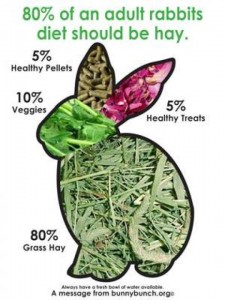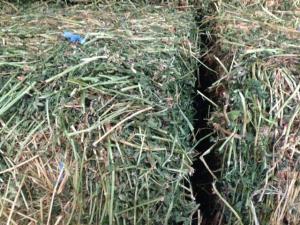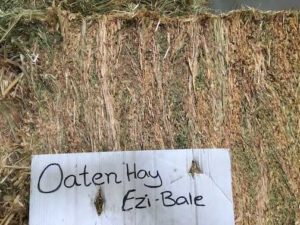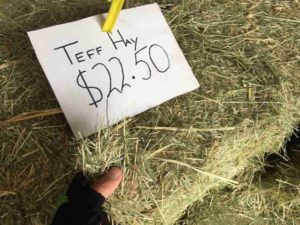Of all the species we care for as pets, rabbits surely get the most harmful diets. The advice people get and the food available to buy is almost all very inappropriate and leads to shorter, unhealthier lives.
Why Rabbits Need Special Foods

The key to understanding what makes a good or a bad rabbit diet is to look at both the wild diet of the rabbit and their teeth and gastrointestinal tract. The rabbit gut is much more complex than ours and ferments complex carbohydrates from plant roughage to gain nourishment.
The fermentation chamber is a large caecum, which is equivalent to a giant appendix, which takes up most of the space in the abdomen. Their teeth grow continuously to account for the constant grinding of the fibre-rich diet.
Gastric Stasis
If rabbits do not eat the same extremely high fibre diet they get in the wild, the contents of the caecum start to form a sludge which stops flowing in and out as it should. Gastric stasis develops and rabbits stop eating. The consequences can be fatal.
Read more about gastric stasis in rabbits here.
Gut Flora Imbalance
In addition, if rabbits are fed simple carbohydrates, such as grains, molasses, bread or sugars, these will rapidly ferment into harmful substances like lactate which harm the “good’ protective bacteria and favour overgrowth of fatal pathogens.
Molar Overgrowth
Lastly, low fibre diets don’t provide enough abrasion for the constantly growing teeth, causing painful spurs or tooth root impaction, and possible starvation.
Read about treating overgrown teeth here.
Before some specific advice, let’s explore the general do’s and don’ts of feeding rabbits:
Good Rabbit Care
- Feed a diet based around hay (see below)
- Use veges and greens as treats only
- Provide fresh water daily
- Check the dropping output daily
- Feed to maintain an ideal body weight, NOT appetite
Bad Things To Feed Rabbits

- ‘Rabbit muesli’ and high carb pellets
- Fruits and sweets
- Any parts of ornamental plants and trees
- Avocado, rhubarb, asparagus, tomato or potato
- Cereals, bread, biscuits or grains
- Iceberg/light lettuce varieties (loose stools)
- Lucerne (alfalfa) or Clover hay (excessive protein and calcium levels)
- Unprocessed lupins, nuts or seeds (gastric obstruction)
Rabbit diets should include:
Grass hay

Such as Timothy, Oaten, Teff, Wheaten, Pasture, Paddock, Meadow or Ryegrass. About 80% of your rabbits’ diet should be hay and always be available. How much hay? Studies tell us that hay won’t make rabbits fat even if you give them as much as they want. This will help keep them occupied as well as helping to wear down their teeth and prevent dental problems. A high fibre diet also aids in digestion and prevents gut stasis.

Hay quality varies greatly. It should look like dried green grass, not stiff yellow stems (straw) and certainly not oval leaves (lucerne or clover). Our advice is to shop around and look in fodder stores as well as pet suppliers.
Teff hay is hard to find but may be a better choice when available. This photo was taken at Sanders Fodder, Gawler.
Some of our clients have found good quality hay available online at this store.
Fresh Items
Fresh vegies and leafy greens should be no more than ¼ cup daily. A common mistake is to think this is the ‘healthy’ part of their diet, but if we look at wild rabbits they do not usually have access to many vegetables as a food source. It is better to regard this as a ‘treat’ or ‘junk food’.
By limiting the veges and greens, your rabbit will stay hungry to eat enough hay to keep them healthy. Just like not giving kids treats around mealtimes!
Quality pellets
Let us say this as plainly as possible. It is perfectly fine for your rabbit to have no pellets at all. If you must, a fortified high fibre, low grain pellet such as ‘Oxbow’ is far better than supermarket options. Feeding rabbits one tablespoon of pellets per day is recommended.
Many rabbit groups instead recommend Hygain Zero pellets as a low starch and low sugar option. Don’t be put off by the horse on the label; horses and rabbits share a very similar gut prone to similar problems. This might be a better choice if you need to feed more pellets to rabbits that cannot or will not consume enough hay.
Items To Chew
Chew toys to help wear down teeth and keep them occupied– fresh cut branches from fruit trees (not cherry or apricot), wooden blocks, cardboard boxes, roots and sticks, paper towel/toilet paper rolls etc
VEGETABLES – choose just three to allow the gut to adapt
| Watercress | Asparagus | Capsicum | Parsnip | Carrot (minimal) |
| Spring greens | Baby sweetcorn | Snow peas | Turnip | Chicory |
| Spinach | Beetroot | Green beans | Celery | Cucumber |
| Dark lettuce | Broccoli | Fennel | Celeriac | Zucchini |
| Rocket | Brussel sprouts | Parsnip | Cauliflower | Bok Choy/Asian Greens |
| Radish tops | Cabbage | Curly Kale | Carrot tops | Sweet Potato |
| Squash | Pumpkin | Cucumber | Silver beet | Endive |
WILD GARDEN HERBS/WEEDS/FLOWERS
| Thistle | Nettle | Nasturtium |
| Camomile | Lavender | Dill |
| Dandelions (diuretic) | Couch Grass | Plantain |
| Clovers (leaves and flowers) | Fresh Grass (avoid if lush) | Borage |
| Basil | Mint | Rosemary |
| Coriander | Parsley | Oregano |
Most weeds found growing in lawns are safe, BUT avoid flowering ornamental plants as these are generally toxic
